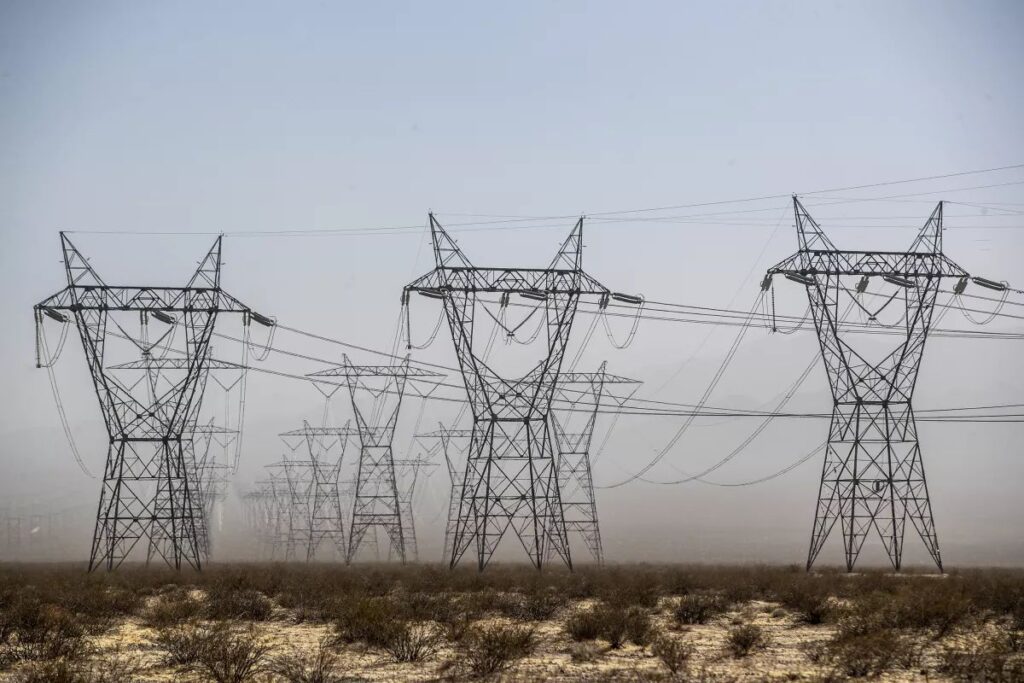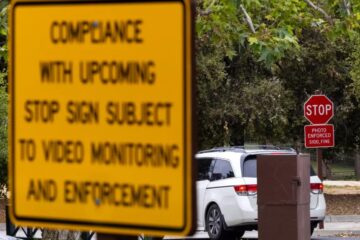California’s race against time to build power lines
Building out the state’s electric grid to meet climate change goals won’t be fast or cheap.
Source of this article, the Los Angeles Times, April 10, 2023.
Want to live in a world where heat waves stop getting hotter, wildfires stop getting bigger, water shortages stop getting more severe and storms stop getting more destructive?
Then you should probably cozy up to electric power lines.

Power lines run through California’s Imperial Valley, an agricultural region that also produces growing amounts of solar energy.
Solar panels and wind turbines take up a lot of the oxygen in conversations about clean energy solutions. But for solar and wind to supply ever-larger amounts of electricity — and replace the coal, oil and natural gas cooking the planet — the United States will need a lot more transmission lines, to carry renewable electricity from the nation’s sunniest, windiest places to the big cities that suck up huge amounts of power.
How significant is the need for new transmission? The REPEAT Project, which is led by Princeton University researchers, reported last year that 80% of the potential cuts in carbon pollution made possible by the Inflation Reduction Act — the climate bill signed by President Biden — could be lost if the U.S. fails to accelerate the build-out of its electric grid.
There’s a similar reality at work in California, where state law requires 90% clean energy by 2035 and 100% by 2045 — on a power grid big enough and robust enough to support tens of millions of electric cars, home heating systems and stoves.
A new report puts some numbers to the urgent need to build power lines — and upgrade existing wires.
Over the next decade, the California Independent System Operator says in the draft report, the state should spend at least $7.5 billion on transmission projects that would support renewable energy growth. Plus another $1.8 billion on projects that would help prevent blackouts — which are getting more difficult to avoid as rising temperatures drive up demand for air conditioning, and as the power grid becomes increasingly reliant on solar panels that stop generating electricity after dark.
Those new and upgraded power lines would be paid for largely by customers of the state’s major monopoly utility companies: Southern California Edison, Pacific Gas & Electric and San Diego Gas & Electric. The billions of dollars in expenditures would add to utility bills at a time when electricity costs are already rising rapidly, straining cash-strapped families and making it less likely that Californians will want to replace their fossil-fueled cars, furnaces and stoves with electric alternatives.
Nobody said solving the climate crisis would be easy. But getting the ball rolling on new power lines has been especially tough. Hardly anybody wants to pay for them, even if they’ll save money — and lives — in the long run. And getting permission to string wires over long distances — with some routes traversing multiple states and hundreds of landowners — can take a decade or more.
So what kinds of tricks might California have up its sleeve? Here are four things to know.
1. This isn’t a new problem
It’s been clear for at least a decade that new and upgraded power lines would be needed to facilitate construction of more solar farms in California’s Central Valley, geothermal plants by the Salton Sea and floating wind farms off the coast.
But for the most part, those projects haven’t gotten built. Inertia has prevailed over action.
When I asked Elliot Mainzer — chief executive of the California Independent System Operator, which oversees the electric grid — whether anything’s really going to change after his agency’s report, he offered several reasons for optimism.
First, he said, the system operator reached a new agreement in December with the state’s Public Utilities Commission and Energy Commission, the other entities responsible for planning and approving power grid projects. It should lead to closer coordination among the agencies as they provide direction to companies proposing power plants and transmission lines, he said.
Second, the system operator is reworking its process for responding to “interconnection requests,” in which energy developers apply to hook up their power projects to the grid. Right now, there are so many requests — many of them for plants unlikely to ever get built — that the agency is moving far too slowly to study and approve badly needed solar and wind farms.
Better processes don’t always lead to better outcomes. But Mainzer insists these are important steps.
“We’re trying to take any barriers off the table,” he said. “It’s a big lift. But failure’s not an option.”
The draft report still needs to be approved by the system operator’s board of governors. And even if the board signs off on the billions of dollars in projects, the Public Utilities Commission still needs to give them the OK, too — a much bigger lift.
2. We’re talking mind-boggling amounts of clean power
Some of the numbers in the new report are hard to wrap your head around.
Right now, California has just over 80 gigawatts of electric generating capacity. The system operator and other agencies envision adding 70 gigawatts over the next decade — and an additional 50 gigawatts by 2045, the deadline for 100% clean energy.
So we’re talking about more than doubling the size of the power grid.
The transmission projects outlined in the report would enable 17 gigawatts of solar development, from the Central Valley to the Mojave Desert to neighboring regions of Nevada and Arizona; eight gigawatts of offshore wind; eight gigawatts of onshore wind, more than half of it coming from Idaho, New Mexico and Wyoming; and at least a gigawatt of geothermal energy.
Those facilities could dramatically reduce the need to burn natural gas, which in 2021 supplied more than one-third of the state’s electricity. But they wouldn’t eliminate the need for gas plants, many of which are in low-income communities of color burdened by high levels of air pollution. Even with lots of new solar and wind — and batteries — officials expect there will still be a need for gas turbines that can be fired up on the hottest summer days, when demand for air conditioning strains the power grid.
One transmission line not yet endorsed by the California Independent System Operator could change that equation.
The report notes that the system operator has had discussions with the L.A. Department of Water and Power — which runs its own independent electric grid — about an undersea cable called the Pacific Transmission Expansion. The proposed multibillion-dollar power line would hug the California coast for 200 miles, with the ability to carry offshore wind energy to the Los Angeles Basin and potentially reduce the region’s reliance on a fleet of dirty — and at least recently, expensive — gas plants.
Will Los Angeles take the unusual step of partnering with other power providers on the undersea cable, which could reduce costs to ratepayers and help bring the project to fruition? Possibly. DWP spokesperson Ellen Cheng told me via email that the utility has identified the proposal as “an opportunity for collaboration with neighboring electric utilities in the region.”
3. None of this will be cheap
The system operator estimates that the $9.3 billion in projects it’s recommending would raise electricity costs by half a cent per kilowatt-hour — a small fraction of the 26 cents, on average, that homes served by SoCal Edison currently pay.
But with electricity bills forecast to keep rising for all sorts of reasons — including utility investments to prevent wildfire ignitions, the costs of which are passed along to customers — lawmakers and regulators are justifiably wary of anything that will add to the burden on low- and middle-income families. Even power lines needed to confront the climate crisis.
“We’re trying to come out with the most efficient, cost-effective plan we possibly can,” Mainzer said. “This is going to unleash a tremendous amount of clean energy and help support reliability for the fourth-largest economy in the world.”
Four of the most expensive transmission projects recommended by the system operator — with an estimated cost of more than $5 billion combined — will be put out for competitive bidding. That means rather than Edison, PG&E or SDG&E being awarded the lucrative projects by default, independent developers will have an opportunity to step in at a lower cost.
Houston-based developer Grid United may submit a bid. Chief Executive Michael Skelly — whose efforts to string electric lines from the wind-rich Oklahoma Panhandle to Tennessee were the focus of a book about the challenges of building transmission — told me he thinks California will be able to actually move projects forward. He praised the system operator for taking a proactive approach in its new report, mapping out where specific power lines will be needed to enable renewable energy growth.
“California is saying, ‘OK, y’all are ready. We’re here to receive you with open arms,’” Skelly said.
Although competitive bidding could lower costs for some power lines, it won’t address a key reason other transmission projects are so expensive: guaranteed profit margins authorized by the Federal Energy Regulatory Commission, which allow utilities such as Edison and PG&E to charge customers not only for the costs of building a line, but also a cut for their shareholders. Critics say the profits allowed by the agency are far too high, while utilities counter that they’re needed to reduce financial risks.
When I asked Mainzer about the utility profit question, he told me he doesn’t have “a major position on that.”
4. Getting permission to build is not easy
Two recent reports show just how hard it can be to build power lines in California.
One, from the Clean Air Task Force, lays out the arduous approval process at the Public Utilities Commission, with environmental reviews required by the California Environmental Quality Act that can take as long as four years. The other report, from consulting firm GridLab and clean energy advocacy group CEERT, notes that it took 12 years for Edison to finish a project to bring thousands of megawatts of wind power from the Tehachapi area in Kern County to the Los Angeles Basin.
The Public Utilities Commission process “is too cumbersome and takes too long,” said V. John White, CEERT’s executive director. He thinks the state’s Energy Commission ought to take over permitting from the beleaguered utilities commission.
“We’ve got to make it go faster, better, cheaper,” White said.
Several bills proposed in the Legislature could speed things up.
One of them, Senate Bill 420, from Sen. Josh Becker (D-Menlo Park), would allow state officials to designate power line proposals as “environmental leadership development projects.” That would require environmental lawsuits designed to block those lines to be resolved within 270 days. The legislation would also eliminate what Becker’s office describes as “duplicative economic review” at the utilities commission for transmission projects already deemed necessary by the system operator.
Then there’s Senate Bill 619 from Sen. Steve Padilla (D-Chula Vista), which would designate high-priority transmission lines for fast-track state review. Plus Assembly Bill 914 from Assemblymember Laura Friedman (D-Glendale), which would exempt some power line projects from the California Environmental Quality Act if they would help the state meet its climate goals.
“These projects are transformational for California,” White said. “We can’t treat them as unimportant.”
Something’s got to give.





0 Comments